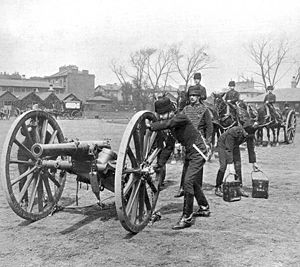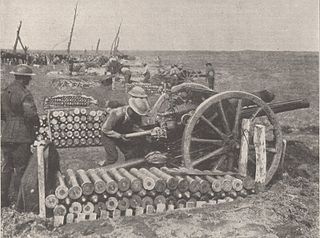
The Ordnance QF 18-pounder, or simply 18-pounder gun, was the standard British Empire field gun of the First World War-era. It formed the backbone of the Royal Field Artillery during the war, and was produced in large numbers. It was used by British Forces in all the main theatres, and by British troops in Russia in 1919. Its calibre (84 mm) and shell weight were greater than those of the equivalent field guns in French (75 mm) and German (77 mm) service. It was generally horse drawn until mechanisation in the 1930s.

The Ordnance BL 60-pounder was a British 5 inch (127 mm) heavy field gun designed in 1903–05 to provide a new capability that had been partially met by the interim QF 4.7 inch Gun. It was designed for both horse draft and mechanical traction and served throughout the First World War in the main theatres. It remained in service with British and Commonwealth forces in the inter-war period and in frontline service with British and South African batteries until 1942 being superseded by the BL 4.5 inch Medium Gun.

The Ordnance BL 6 inch 26cwt howitzer was a British howitzer used during World War I and World War II. The qualifier "26cwt" refers to the weight of the barrel and breech together which weighed 26 long hundredweight (1.3 t).

The Ordnance QF 13-pounder (quick-firing) field gun was the standard equipment of the British and Canadian Royal Horse Artillery at the outbreak of World War I.
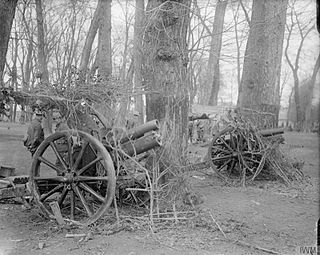
The Ordnance QF 4.5-inch howitzer was the standard British Empire field howitzer of the First World War era. It replaced the BL 5-inch howitzer and equipped some 25% of the field artillery. It entered service in 1910 and remained in service through the interwar period and was last used in the field by British forces in early 1942. It was generally horse drawn until mechanisation in the 1930s.

The BL 8-inch howitzer Mark I through to Mark V were a British improvisation developed early in the First World War to provide heavy artillery. It used shortened and bored-out barrels from various redundant naval 6-inch guns.

The Ordnance BL 6 inch 30cwt howitzer was a British medium howitzer used in the Second Boer War and early in World War I. The qualifier "30cwt" refers to the weight of the barrel and breech together which weighed 30 hundredweight (cwt) : 30 × 112 lb = 3,360 lb. It can be identified by the slightly flared shape of the muzzle and large recuperator springs below the barrel.

The 13 pounder 9 cwt anti-aircraft gun became the standard mobile British anti-aircraft gun of the World War I era, especially in theatres outside Britain.

The BL 6-inch gun Mark VII was a British naval gun dating from 1899, which was mounted on a heavy travelling carriage in 1915 for British Army service to become one of the main heavy field guns in the First World War, and also served as one of the main coast defence guns throughout the British Empire until the 1950s.

The QF 2.95-inch mountain gun was the designation given by the British to a Vickers 75 mm calibre gun. It was originally produced for the Egyptian Army. It was taken into British service in the late 19th century to provide the 'movable armament' at some coaling stations. Also known as "The Millimetre Gun", it was used by the West African Frontier Force in several theatres in Africa during World War I. It was also used by the United States and the Commonwealth of the Philippines.
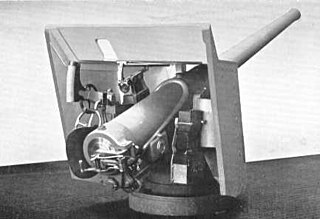
The QF 4.7-inch Gun Mks I, II, III, and IV were a family of British quick-firing 4.724-inch (120 mm) naval and coast defence guns of the late 1880s and 1890s that served with the navies of various countries. They were also mounted on various wheeled carriages to provide the British Army with a long range gun. They all had a barrel of 40 calibres length.

The Ordnance BL 5-inch howitzer was initially introduced to provide the Royal Field Artillery with continuing explosive shell capability following the decision to concentrate on shrapnel for field guns in the 1890s.

The Ordnance BLC 15-pounder gun was a modernised version of the obsolete BL 15-pounder 7 cwt gun, incorporating a recoil and recuperator mechanism above the barrel and a modified quicker-opening breech. It was developed to provide Territorial Force artillery brigades with a reasonably modern field gun without incurring the expense of equipping them with the newer 18-pounder. It is the gun that writers usually mean by "15-pounder gun" in World War I, but can be confused with the earlier Ordnance QF 15-pounder Ehrhardt or Ordnance BL 15-pounder, both of which fired the same shell.

The Ordnance QF 15-pounder gun, commonly referred to as the Ehrhardt, was a modern German field gun purchased by Britain in 1900 as a stopgap measure to upgrade its field artillery to modern QF standards, while it developed its own alternative. This was precipitated by the experience of the British Army in South Africa during the Second Boer War, where its standard field gun, the BL 15-pounder, was out-performed by modern French and German field guns deployed by the Boers. It bore no relation to the BL 15-pounder or BLC 15-pounder, two other guns in British service at the time, other than a common shell.

The Ordnance BL 15-pounder, otherwise known as the 15-pounder 7 cwt, was the British Army's field gun in the Second Boer War and some remained in limited use in minor theatres of World War I. It fired a shell of 3-inch diameter with a maximum weight of 15 pounds (6.8 kg), hence its name which differentiated it from its predecessor '12-pounder' 3-inch gun which fired shells weighing only 12.5 pounds (5.7 kg).

The QF 6-inch 40 calibre naval gun (Quick-Firing) was used by many United Kingdom-built warships around the end of the 19th century and the start of the 20th century.
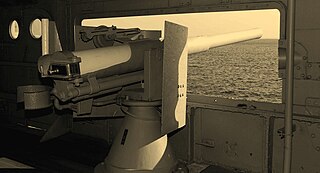
The QF 12-pounder 12-cwt gun (Quick-Firing) was a common, versatile 3-inch (76.2 mm) calibre naval gun introduced in 1894 and used until the middle of the 20th century. It was produced by Armstrong Whitworth, Elswick and used on Royal Navy warships, exported to allied countries, and used for land service. In British service "12-pounder" was the rounded value of the projectile weight, and "12 cwt (hundredweight)" was the weight of the barrel and breech, to differentiate it from other "12-pounder" guns.
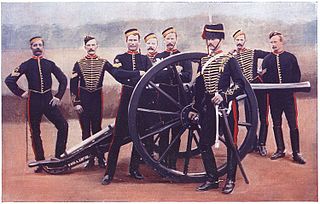
The Ordnance BL 12-pounder 7cwt was the British Army's field gun which succeeded the RML 13-pounder 8 cwt in 1885.

The BL 6-inch gun Marks II, III, IV and VI were the second and subsequent generations of British 6-inch rifled breechloading naval guns, designed by the Royal Gun Factory in the 1880s following the first 6-inch breechloader, the relatively unsuccessful BL 6-inch 80-pounder gun designed by Elswick Ordnance. They were originally designed to use the old gunpowder propellants but from the mid-1890s onwards were adapted to use the new cordite propellant. They were superseded on new warships by the QF 6-inch gun from 1891.

The QF 4-inch gun Mks I, II, III were early British QF (quick-firing) naval guns originating in 1895. They all had barrels of 40 calibres length.
